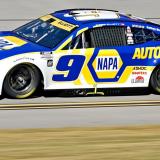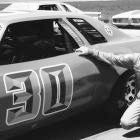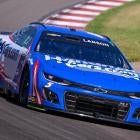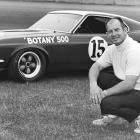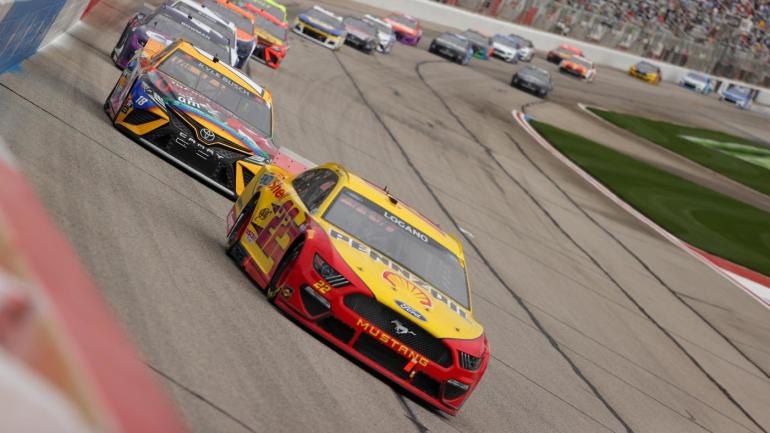
There are few things a race car driver enjoys quite like a classic speedway with old, worn-out asphalt. As the changing seasons turn a track's asphalt from black and smooth to grey and rough, what generally occurs is that a track becomes harsher on tires, the racing groove expands, and drivers can use every inch of the race track to find grip and make passes as they slip and slide on the edge of control -- just as they will do this weekend at Atlanta Motor Speedway.
But after nearly 25 years, this weekend's Quaker State 400 will be the final race for Atlanta's current coat of asphalt. On Tuesday, Atlanta Motor Speedway announced that it will not only be re-paved for the 2022 season, but that other alterations will be made to the racetrack. The speedway's turns will be steepened from 24 to 28 degrees of banking, and the racing surface in the turns will also be narrowed from 55 to 40 feet.
The idea behind Atlanta's re-profiling is to optimize the speedway -- which first opened in 1960 -- for NASCAR's Next Gen car debuting in 2022, theoretically bringing the field closer together and creating racing conditions that resemble those seen on superspeedways.
All new for '22!
— Atlanta Motor Speedway (@amsupdates) July 6, 2021
The next generation of Atlanta Motor Speedway!
Get the details ➡️ https://t.co/X6T7IL05Y0 pic.twitter.com/MzPKIHlVja
"As Atlanta's racing surface has aged, we've challenged ourselves to reimagine what NASCAR racing at an intermediate track can be," read a statement by Speedway Motorsports President and CEO Marcus Smith. "With high banks in the turns, narrower width and new pavement technology, Atlanta will be unlike any other mile-and-a-half track on the circuit. It's all new for '22 and this will be specifically designed for close, competitive racing."
While it had been dreaded by the competitors to the point that they successfully lobbied to prevent a repave of Atlanta in 2017, Atlanta's old surface being repaved was seemingly inevitable as the issues that accompany worn out pavement -- such as the creation of "weepers" when it rains and the risk of the pavement crumbling and falling apart -- seeped further into the realm of possibility.
But the addition of banking and the narrowing of the racing surface has elicited grumbling from the drivers, several of whom felt they were not consulted and did not have a say in NASCAR and Atlanta's plans for the track's future.
"I wish they would kind of talk to everybody about it. I think a lot of us drivers were kind of caught off-guard," Kyle Larson told reporters. "... We're gonna go put on a good show no matter how the track is. But we have more experience than the fans I guess would be the argument that I would have. I've raced at hundreds of different racetracks, and I feel like we would have a better understanding of what really makes good racing.
"But fans like crashes, and a 40 foot wide surface is gonna keep us tight together. So maybe that's gonna accomplish the 'good racing' that we think it is."
Larson's comments allude to existing disconnects over what constitutes "good racing" in NASCAR, as a mini-culture war has emerged between the forces trying to bunch the field together and create pack racing conditions enjoyed by fans and a traditional emphasis on handling and tire wear enjoyed by drivers, which often creates a spread out field.
Over the last quarter-century, the Atlanta Motor Speedway has been the site of some of the finest races of the latter category. But even if the track's future pavement ages as the old one has, such races may not come again thanks to the new nature of the speedway.
"I'm definitely not optimistic that it will get back to where it is now," Christopher Bell told CBS Sports. "It's currently, in my opinion, in its prime. And the racing that we see there is very, very unique with the age of the surface, how bumpy it is, how it wears out tires. It's one of very few right now. You can probably put Homestead [Speedway] in that category, but that's pretty much it.
"With them going and reconstructing Atlanta, it's going to dramatically change the name of the game. I think we'll see racing similar to Talladega and Daytona at "Atlanta Superspeedway" moving forward."
In a report by Bob Pockrass of Fox Sports, Steve Swift of Speedway Motorsports Inc. acknowledged that when a driver is happy about a race track, "usually the fans aren't." Regardless, Swift alluded to the desire to make Atlanta Motor Speedway unique among the 1.5 mile tracks on the NASCAR schedule as the prospect of repaving became more and more of a necessity.
"It's at that stage, you're on pins and needles through the weekend," Swift said. "Between nights this coming weekend, we'll patch 100 feet of those seams because they'll come up. … We put glue in it and hold it together. It definitely is time."
This will mark the second time in the history of Atlanta Motor Speedway that the track has undergone a major redesign. Following the spring of 1997, the track was converted from a traditional oval into a quad oval, with a "dog-leg" being added to the track configuration and the old front straightaway becoming the back straightaway.







